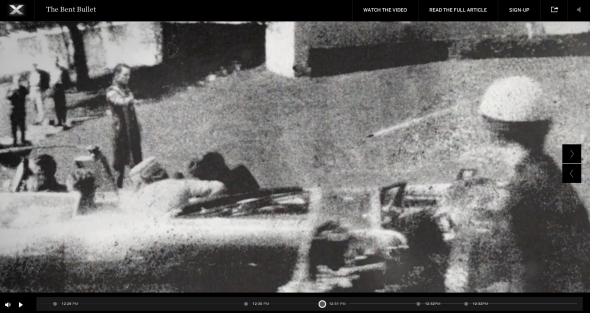The Bent Bullet: JFK and the Mutant Cospiracy
Posted: December 10, 2013 | Author: fra30774 | Filed under: Digital, Promotion, Social, USA, Viral | Tags: 1963, days of future, JFK, Magneto, nov. 22, the bent bullet, Viral, x-men | Leave a commentMarvel has created a site called The Bent Bullet, a promotional website and video that weaves X-Men mutants in with a JFK conspiracy theory, blending the real and fictional in a quasi sort of alternative history genre getup.

A new viral site promoting the upcoming X-Men: Days of Future Past has hit the web: The Bent Bullet, which explores President John F. Kennedy’s assassination — with an unfamiliar twist.
According to The Bent Bullet site, which went up last night, Kennedy was assassinated by Lee Harvey Oswald — with the help of Magneto (played in his young incarnation by Michael Fassbender in the movie), who allegedly used his powers on Oswald’s wild shots to ensure the president’s death. This, it seems, will be the incident that splits the X-Men timeline, triggering the dystopian Days of Future Pastuniverse, in which mutants have been rounded up in internment camps and systematically exterminated with the aid of robotic Sentinels.
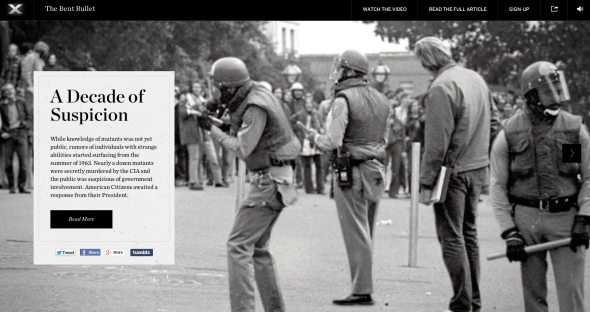
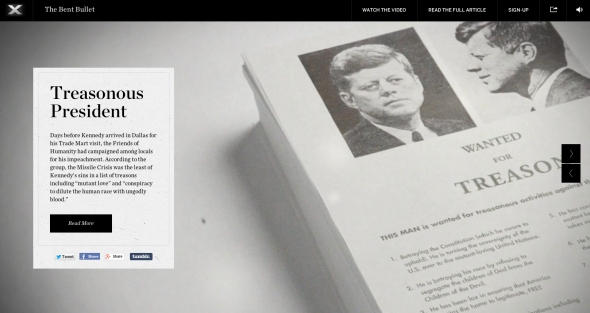
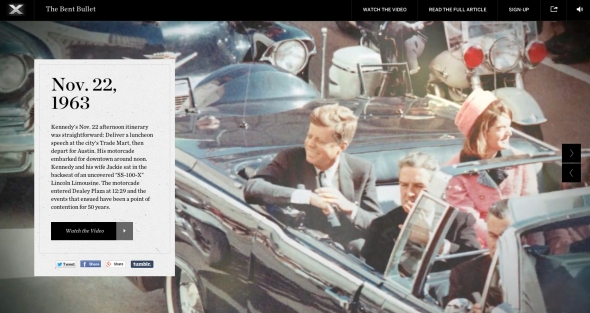
But has Magneto been falsely accused? Fictional journalist Harper Simmons seems to think so — and both Magneto’s own testimony and circumstantial evidence point to Mystique (Jennifer Lawrence) committing the assassination while disguised as Oswald, then slipping away and leaving the real Oswald to take the blame. However, it’s unclear whether she did so on Magneto’s orders, or acted autonomously following a schism in the Brotherhood of Mutants.
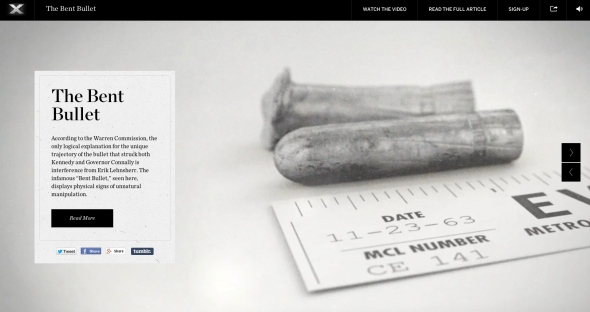
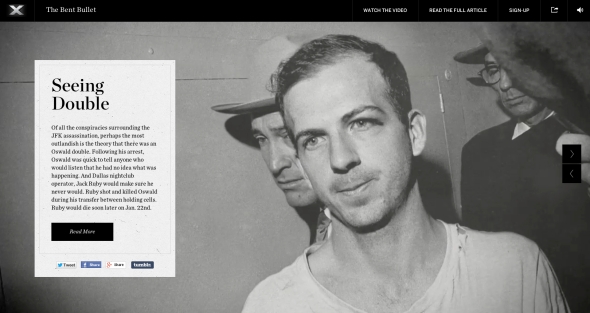
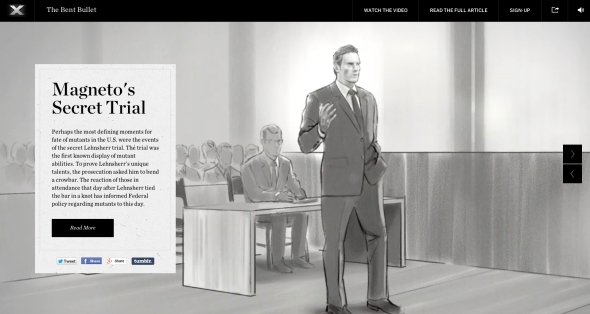
Like the rest of what we’ve seen of Days of Future Past, the movie’s take on the trigger event is based very directly on the comic, with some major modifications. In the original story, the assassin was Mystique, leading an autonomous brotherhood — but her targets were Charles Xavier, Moira McTaggart, and hardline anti-mutant senator Robert Kelly, whose cinematic counterpart died in 2000′sX-Men and was later impersonated by Mystique.
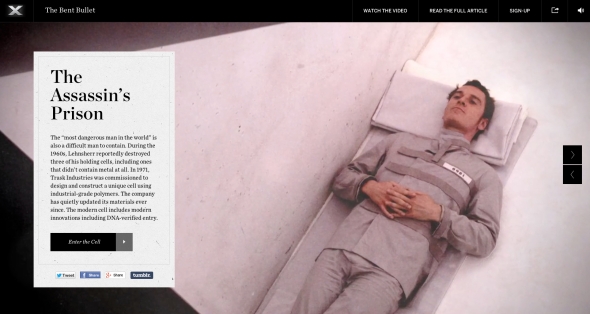
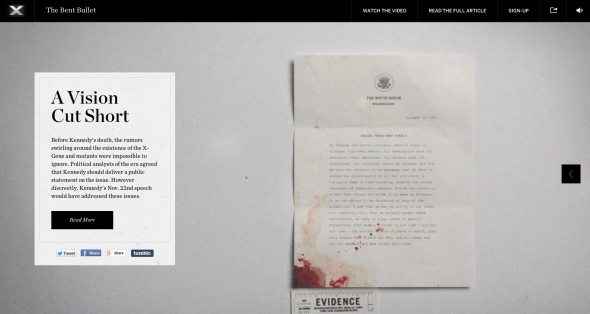
To find out just how closely the rest of Days of Future Past adheres to the comic, will have to wait until flick hits theaters May 23, 2014 — or they’ll have to hope more of these teaser sites are on the way.
100 (from 0 to 100 years in 150 seconds) – A documentary by Jeroen Wolf
Posted: November 27, 2013 | Author: fra30774 | Filed under: Art, Viral | Tags: 100, age, Amsterdam, documentary, from o to 100 years in 150 seconds, Jeroen Wolf, people, Viral | Leave a comment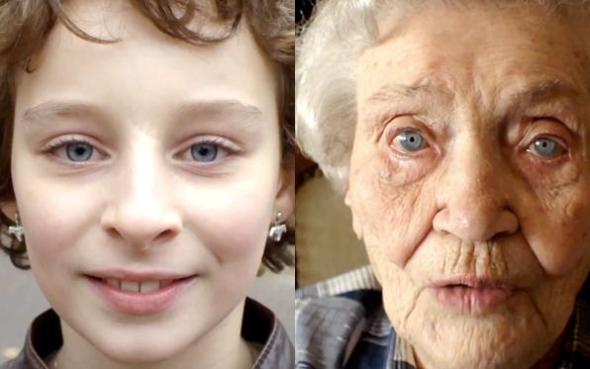
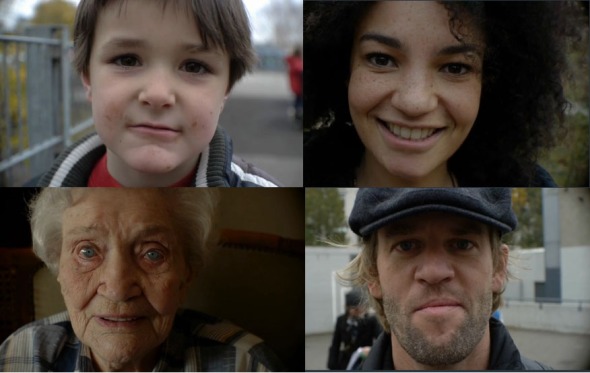
Using a Panasonic GH2, Dutch filmmaker Jeroen Wolf captured people ranging from 1 year young to 100 years old. It’s simple—the person stares at the camera at states their age—yet incredibly touching to see the growth and experience you earn as the years add up.
Wolf actually started the project last October by documenting people in Amsterdam but the project petered out because it was difficult to find very young and very old subjects. Wolf says:
“I found my very old ‘models’ in care homes and it was a privilege to document these—often vulnerable—people for this project. I had particular problems finding a 99 year-old. (Apparently 100 year-olds enjoy notoriety, but a 99 year-old is a rare species…) And when I finally did find one, she refused to state her age. She simply denied being 99 years old! But finally, some 4 months after I recorded my first ‘age’, I was able to capture the ‘missing link’ and conclude this project. “
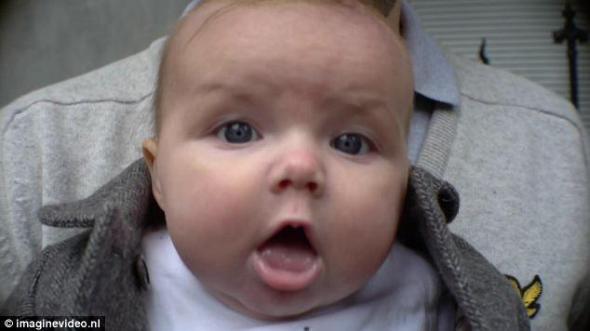
From Coke to Mikado – Don’t Underestimate the Power of a Red Button
Posted: March 13, 2013 | Author: fra30774 | Filed under: Ambient, Australia, Awards, Belgium, Beverages, Brazil, Cannes Lions, Case History, Cliché, Direct, Event, France, Installation, Press/Outdoor, Promotion, TV/Film, USA, Viral | Tags: Ambient, Belgium, Buzzman, Cannes Lions, Case History, Clemenger BBDO, Coca-Cola, Duval Guillaume, fantastic delites, France, funny, Happiness Truck, installation, Mikado, push the red button, push to add drama, resistence test, TNT Tv Channel, USA, Viral | Leave a comment
Mikado – Resistance Test
Advertising Agency: Buzzman, Paris, France
CEO / Creative Director: Georges Mohammed-Chérif
Art Director: Louis Audard
Copywriter: Tristan Daltroff
Art Director Assistant: Clément Séchet
Year: 2013
TNT TV Channel – Dramatic surprise on an ice-cold day
Advertising Agency: Duval Guillaume Modem, Brussels
Creative Director: Geoffrey Hantson, Katrien Bottez
Copywriter: Dieter De Ridder
Art Director: Ad Van Ongeval
Production Company: Czar
Director: Koen Mortier
Year: 2013
Fantastic Delites – How Far Would You Go?
The Delite-o-matic is an interactive vending machine that dispenses free packs of Fantastic Delites simply by pushing a button hundreds of times or by performing challenges. The Delite-o-matic was put out on the streets to prove that because Fantastic Delites taste so good, people will go to incredible lengths to get their hands on them.
Advertising Agency: Clemenger BBDO, Australia
Creative Director: Karl Fleet
Digital Creative / Art Director: Oliver Prenton
Digital Creative / Copywriter: Matt O’Grady
Year: 2012
TNT TV Channel – Big Red Push Button
To launch the high quality TV channel TNT in Belgium we placed a big red push button on an average Flemish square of an average Flemish town. A sign with the text “Push to add drama” invited people to use the button.
Advertising Agency: Duval Guillaume Modem, Brussels
Creative Director: Geoffrey Hantson, Katrien Bottez
Copywriter: Dieter De Ridder
Art Director: Ad Van Ongeval
Production Company: Czar
Director: Koen Mortier
Year: 2012
Coca-Cola – Happiness Truck
A Coca-Cola delivery truck is converted into a happiness machine on wheels delivering “doses” of happiness in the streets of Rio De Janeiro, Brazil. Where will happiness strike next?
Advertising Agency: Definition 6, Atlanta
Year: 2011
Crispin Porter + Bogusky for Just Dance 3 – Autodance
Posted: January 22, 2013 | Author: fra30774 | Filed under: Awards, Cannes Lions, Case History, Digital, Promotion, Sweden, Viral | Tags: Adore You, Anyone can Just Dance, app, Autodance, Cannes Lions, Case History, Crispin Porter + Bogusky, Digital, funny, Jim Connolly, Just Dance 3, Mattias Berg, Ubisoft, Viral | Leave a comment
Just Dance is the fun dance game series that anyone can pick up and play. But until now, the audience has been limited to teenage girls. For the launch of Just Dance 3, the brief was to expand the audience, with no media spend.
To promote the release of Just Dance 3, Crispin Porter + Bogusky created Autodance, an app that proves anyone can Just Dance. Simply record your friends doing stuff and the app syncs their movements to a choice of dance tracks from the video game. Like magic, your friends will be shaking their stuff in a branded music video that can be shared online.


Autodance is more than just a fun app. It’s a fun tool to get people to make and share our ads for us. Each user-generated video acts as an advert for Just Dance 3, and features our tagline “Anyone can Just Dance”, along with an end card for the game.
The app proved so successful it’s now been incorporated into Just Dance 4.

With no media spend, Autodance exposed Just Dance 3 to a new audience of millions. And over Christmas 2011, Just Dance 3 became the best-selling video game in Europe.
Results:
App Downloads: 6.3 Million
User-generated videos: 32 Million
Video views (in phone): 118 Million
Video views (on Facebook): 32 Million
Total video shares (Facebook and Youtube): 2.9 Million
Facebook likes: 4.3 Million
Facebook comments: 2.4 Million
Advertising Agency: Crispin Porter + Bogusky, Gothenburg
Creative Director: Mattias Berg
Copywriter: Jim Connolly
Art Director: Mattias Berg
Production Company: Adore You
Chief Creative Officer: Rob Reilly
Executive Creative Director: Gustav Martner
Executive Creative Director: Bjorn Hoglund
Creative Technology Director: Per Rundgren
Head of Interactive: Marcus Aslund
Interactive Developer: Martin Furuberg
Motion Designer : Motion Designer Jörgen Bengtsson
Visual Designer: Stephano Dinamarca Fernández
Visual Designer: Mattias Nordenham
Year: 2011

Diesel – Happy Apocalypse
Posted: December 20, 2012 | Author: fra30774 | Filed under: Cliché, Digital, UK, Viral | Tags: 21-12-2012, Blinkink London, Diesel, end of the world, funny, happy apocalypse, Jonny & Will, Mayan calendar, Vice, Viral | Leave a comment
This new animated spot for Diesel through Vice and Blinkink London and directing team Jonny & Will is a rather risque call to arms…According to the ancient Mayan calendar, December 21st 2012 marks the day the Earth will be destroyed and all human life will cease to exist forevermore. So, if the rumour is true and 21-12-2012 really is the day it all ends, surely there’s only one thing to do?
McCann Australia for Metro Trains Melbourne – Is “Dumb Ways To Die” the new “Chipotle”?
Posted: December 10, 2012 | Author: fra30774 | Filed under: Animation, Australia, Case History, Copywriting, Design, Digital, Graphic, Graphic Design, Illustration, Press/Outdoor, Social, Viral | Tags: Animation, be safe around trains, Case History, Chipotle, Digital, Dumb Ways to Die, Edward Gorey, funny, Is "Dumb Ways To Die" the new "Chipotle"?, John Mescall, Julian Frost, McCann Australia, Melbourne Metro, metro trains, Ollie McGill, The Gashlycrumb Tinies, Viral | Leave a comment“Dumb Ways to Die”, is an integrated advertising campaign designed to curb the number of train-related deaths in Victoria. The campaign is centred around a three-minute animated music video, highlighting the many dumb ways there are to die, with being hit by a train – a very preventable death – among them. The video and iTunes single are accessible online at DumbWaysToDie.com, with animated gifs being released on Tumblr, on radio, in posters on small and large space outdoor and throughout the Metro Trains network, with the lyrics to the song on the art work.
The Idea: Safety PSAs are gloomy and tedious and largely ignored by young people hardwired to resist them—except when they’re irresistibly fun and impossible not to share with friends. McCann Australia managed just such an evolution of the genre with “Dumb Ways to Die” its animated train-safety spot for the Melbourne Metro. The three-minute music video shows adorable blobs making the stupidest decisions ever—messing with animals, sticking forks in toasters, eating superglue, etc.—leading to all sorts of gruesome, fatal accidents. The dumbest way to die, the ad suggests at the end, is by being careless around trains. “The idea for a song started from a very simple premise: What if we disguised a worthy safety message inside something that didn’t feel at all like a safety message?” said McCann executive creative director John Mescall. “So we thought about what the complete opposite of a serious safety message would be and came to the conclusion it was an insanely happy and cute song.” With more than 30 million YouTube views, it seems happy, cute and grisly was the way to go.
The Song: The song begins, “Set fire to your hair/Poke a stick at a grizzly bear/Eat medicine that’s out of date/Use your private parts as piranha bait,” before the chorus repeats the two lines, “Dumb ways to die/So many dumb ways to die.” Mescall wrote most of the lyrics in one night at the agency. “It then took a few weeks of finessing,” he said, “getting rid of a few lines that weren’t funny enough and replacing them with new ones.” The line “Sell both your kidneys on the Internet” was a late inclusion. “I’m glad it’s there. It’s my favorite,” he said.
Australian musician Ollie McGill from the band The Cat Empire wrote the music. “We basically gave him the lyrics and told him to set it to the catchiest nonadvertising type music he could,” said Mescall. McGill delivered something almost unbearably catchy. “The melody is easy to remember and sing along to, the lyrics are fun, bite-sized chunks of naughtiness, and the vocals have just the right amount of knowing innocence,” Mescall said. “It’s a song that you want to hate for living in your head, but you can’t bring yourself to hate it because it’s also so bloody likable.” The singer is Emily Lubitz of another Australian band, Tinpan Orange. (The song is credited to Tangerine Kitty, which is a mashup of the two band names.) “Emily brought a great combination of innocence, playfulness and vocal integrity,” Mescall said. “She brings a level of vocal quality you don’t normally get on a video about cartoon death.”
The Art Direction: Australian designer Julian Frost did the animation. “We gave him the most open brief we could: Just make it really funny and really awesome and do it to please yourself,” said Mescall. The visual reference points ranged from Edward Gorey’s The Gashlycrumb Tinies to Monty Python’s “Always Look on the Bright Side of Life” (which showed men singing while being crucified) to “any number of hokey indie music-video flash mobs you see on YouTube,” said Mescall.
“Julian was keen to contrast the extreme situations described in the lyrics with the simplest animation possible. Otherwise it would become just too much.” After the spot blew up online, Frost wrote on his website: “Well, the Internet likes dead things waaay more than I expected. Hooray, my childish sense of humor pays off at last.”
The spot lives online, in short bursts on music TV, and may reach cinemas. The campaign is also running in radio, print and outdoor. The song is on iTunes, where it reached the top 10. The agency is also producing a book as well as a smartphone game that should be ready by Christmas.
Advertising Agency: McCann, Melbourne
Executive Creative Director: John Mescall
Creative Team: John Mescall, Pat Baron
Animation: Julian Frost
Digital Team: Huey Groves, Christian Stocker
Year: 2012
Adidas: Adicolor Project – United Colors of adidas
Posted: October 24, 2012 | Author: fra30774 | Filed under: Animation, Art, Case History, Design, Digital, Graphic, Graphic Design, Illustration, Promotion, Sportwear, Testimonial, USA, Viral | Tags: adicolor, adidas, Animation, black, Case History, colour, costomization, Digital, green, Happy, idealogue, Neill Blomkamp, personal expression, pink, Psyop, red, Roman Coppola and Andy Bruntel, Saimon Chow and Charlie White, Tronic, USA, Viral, white, yellow | Leave a commentThe adicolor podcast is a series of seven short films created for adidas to celebrate “colour, costomization and personal expression”. The films were created to be specifically viewed on iPods, PSPs and online, which was still a fairly revolutionary proposition back in 2006 when the films were made. A team of excellent directors was put together, with Neill Blomkamp, Psyop, Happy, Tronic, Roman Coppola and Andy Bruntel, Saimon Chow and Charlie White each given an entirely open brief to create a film based on their emotional response to a particular colour. The podcasts related to the adicolor global digital campaign for which adidas had asked 20 artists to design a shoe based on their response to a colour. The films feature such surreal scenes as an orgiastic dinner party involving green paintball splashes and a pink-loving teenager’s transformation into a bejewelled figurine. With an original goal of achieving one million views globally, the campaign actually achieved over 25 million views in just seven weeks.
Adicolor BLACK
Stills from Saiman Chow’s film for the colour BLACK. The film is a surreal tale about a lonely, crazed panda.
Adicolor PINK
Charlie White directed the adicolor PINK film, which sees a teenager turn into a bewelled figurine while her pink teddy looks on helplessly.
Adicolor BLUE
Psyop is behind the adicolor blue film, where New York City is turned black and white, apart from the odd splashes of blue.
Adicolor GREEN
Adicolor green by Happy shows a space-age dinner party where everything gets a little out of hand after some green treats are consumed.
Adicolor WHITE
Adicolor WHITE was directed by Tronic and sees Jenna Jameson enthusiastically playing a funfair game.
Adicolor YELLOW
Neil Blomkamp directed the adicolor YELLOW film, a gripping tale about robots and artificial life.
Adicolor RED
Roman Coppola and Andy Bruntel created this animated history of the colour red for the adicolor RED film.
Advertising Agency: Idealogue, New York
Year: 2006
Wieden + Kennedy for Facebook – The Things That Connect Us
Posted: October 4, 2012 | Author: fra30774 | Filed under: Case History, Copywriting, TV/Film, USA, Viral | Tags: advertising, Airplanes, Alejandro Gonzalez Inarritu, billion people, Bridges., chairs, Doorbells, Facebook, Karl Lieberman, Mark Zuckberg, Rebecca Van Dyck, The Things That Connect Us, TV/Film, USA, Viral, Wieden+Kennedy | Leave a commentToday, Faceboook announced that it had reached its billion-user milestone, and to celebrate, it has launched a poetic film from its agency of record, Wieden & Kennedy in Portland, Ore.
The film, titled “The Things That Connect Us,” opens with a series of artful, emotional vignettes of people sitting and interacting on chairs — before moving on to other objects and events through which folks come together, such as a doorbell, airplanes, bridges or a basketball game. The point being, that all these things exist, perhaps, to remind us that we’re not alone. It was created by Wieden & Kennedy, Portland, Ore., which Facebook today also unveiled as its global agency of record.
“What we’re trying to articulate is that we as humans exist to connect, and we at Facebook to facilitate and enable that process,” explained Rebecca Van Dyck, a former exec for Apple and Levi’s who joined Facebook as head of consumer marketing in February. “We make the tools and services that allow people to feel human, get together, open up. Even if it’s a small gesture, or a grand notion — we wanted to express that huge range of connectivity and how we interact with each other.”
Although it seems to mark a single moment, it’s a vital component of a branding strategy that’s been a year in the making, one not originally intended to coincide with the social network’s milestone moment.
“This started long before we knew we were going to reach a billion,” said Ms. Van Dyck. “We started thinking about this a year ago and approached Wieden & Kennedy to help us craft a message that articulated our values and who we are. It wasn’t until recently that we realized we were close to reaching 1 billion, and we thought what an amazing way to honor our users, to create this piece for them.”
The film launched this morning globally, with an introduction from founder Mark Zuckberg. Ms. Van Dyck said Facebook will also be using its various ad products, including premium page posts and sponsored stories, for the rollout. “We’ll be able to walk the footsteps of what our advertisers go through,” she said.
Although Wieden & Kennedy had previously worked with Ms. Van Dyck while she was at Levi’s, she said the agency preceded her arrival at Facebook and was brought in by Brand Creative Lead Jessica Sittig when the company started to consider a bigger consumer-facing push.
In developing the idea, Wieden Creative Director Karl Lieberman said the agency spent months meeting with Facebook staffers and getting to know the company. “We tried to figure out what it is that the company’s really interested in,” he said. “There’s a quote by David Kennedy that I really love: ‘Great brands don’t talk about themselves, they talk about what they really love.’ If you follow that blueprint, you’ll realize that Facebook loves things that are social. It finds it interesting and essential that there’s this innate, human desire to connect.”
The film was directed by Alejandro Gonzalez Inarritu of Anonymous Content, who directed the critically acclaimed film “Amores Perros” as well as previous high-profile Wieden projects like Nike’s “Write the Future” and the Emmy-awarded “Best Job” Olympics spot for P&G. The agency chose him for his ability to add emotional depth to an idea that on paper, was “almost academic, anthropological,” said Mr. Lieberman. “We knew we needed Alejandro to take a simple, logical argument and bring a true sense of humanity to it. We didn’t want it to feel critical, as the words are pretty straight, so we wanted him to drop that layer of real human emotion on top of it.”
“One of the things that we were really excited about was that he creates epic pieces of film but he can capture the smallest gesture of intimacy and connections, and that was going to be really important for us to get across in a short amount of time,” Ms. Van Dyck added.
In terms of tone, since this would be Facebook’s first major marketing message, “Facebook wanted to speak in a significant, but humble way,” said Mr. Lieberman. “We thought that starting off with chairs really did that. We don’t think about chairs a lot, but you can if you want. You can spend $5 on a chair, or $5,000. They could be incredibly ordinary, or incredibly sophisticated. We thought it was a humble but interesting way for Facebook to start talking about itself.”
Continuing in the humble vein, the ad makes no mention of the billion-user landmark. “We wanted to use 1 billion as the platform and the moment in time, but we didn’t want to turn the message to be back about us in any way,” said Ms. Van Dyck. “We like the idea of using the context of the moment but we wanted the piece to be thoughtful and to be about our users.”
Going forward, Ms. Van Dyck couldn’t disclose any specific marketing plans but said the efforts will continue with the help of Wieden. “The best marketing that we have is people coming to Facebook every day connecting with their friends, families, local business, but every once in a while we’re going to want to define for ourselves who we are and share our values,” she said. “You’re seeing that from us today and it’s a conversation we want to continue with our consumers.”
Zuckerberg gave an additional explanation after announcing Facebook had reached 1 billion active users:
“Celebrating a billion people is very special to me,” he said. “It’s a moment to honor the people we serve. For the first time in our history, we’ve made a brand video to express what our place is on this earth. We believe that the need to open up and connect is what makes us human. It’s what brings us together. It’s what brings meaning to our lives. Facebook isn’t the first thing people have made to help us connect. We belong to a rich tradition of people making things that bring us together. Today, we honor this tradition. We honor the humanity of the people we serve. We honor the everyday things people have always made to bring us together: Chairs, doorbells, airplanes, bridges, games. These are all things that connect us. And now Facebook is a part of this tradition of things that connect us too. I hope you enjoy this video as much as we do. Thanks for helping connect a billion people.”
This is the script:
Chairs. Chairs are made so that people can sit down and take a break. Anyone can sit on a chair and, if the chair is large enough, they can sit down together. And tell jokes. Or make up stories. Or just listen.
Chairs are for people. And that is why chairs are like Facebook.
Doorbells. Airplanes. Bridges. These are things people use to get together, so they can open up and connect about ideas and music and other things that people share.
Dance floors. Basketball. A great nation. A great nation is something people build so they can have a place where they belong.
The Universe. It is vast and dark. And it makes us wonder if we are alone. So maybe the reason we make all of these things is to remind us that we are not.
Coca-Cola Happiness Truck around the World – Where Will Happiness Strike Next?
Posted: October 1, 2012 | Author: fra30774 | Filed under: Argentina, Beverages, Brazil, Canada, Case History, Coca-Cola, Event, France, India, Italy, Malaysia, Mexico, Poland, Promotion, Russia, The Nederlands, The Philippines, Turkey, Viral | Tags: Coca-Cola, Coca-Cola's 125th Anniversary, Coca-Cola's Semangat Truck, coke and meals, Del Campo Nazca Saatchi & Saatchi, Happiness Truck, Olympic edition, rio de janeiro, The Cheering Truck, uefa edition, Viral, Where Will Happiness Strike Next? | Leave a commentInspired by the vending machine that dispensed Coca-Cola and other “doses of happiness” on a college campus in New York and quickly became a global viral video sensation; a specially rigged Coca-Cola delivery truck took to the streets of Rio de Janeiro recently to spread refreshment and smiles to passers-by.
All the action is captured in a two-and-a-half-minute film. In the video, several unsuspecting Brazilians push a button on the back of the truck to dispense Coca-Cola and other fun items such as soccer balls, surfboards and sunglasses.
“‘Happiness Machine’ connected with so many people because the emotion was authentic, unscripted and contagious,” said A.J. Brustein, Global Senior Brand Manager, Coca-Cola. “We wanted to inspire that same feeling again by creating something consumers would respond to and want to share with others because it put a smile on their face.”
Happiness Truck is one of many videos that can be found on the Facebook hub for “Where Will Happiness Strike Next?”. The hub features more than 25 films from around the world that have been created by local Coca-Cola teams to continue the theme of the award-winning “Happiness Machine,” which has generated more than 3 million online views. The interactive site lets consumers search for videos by country and even vote for where they’d like to see happiness strike next.
“We weren’t trying to replace ‘Happiness Machine’ with the ‘Happiness Truck,'” said Christy Amador, Digital Marketing Manager, Global Content Excellence. “We wanted to build on this great idea and continue to answer the question, ‘Where Will Happiness Strike Next?’ by spreading a message of happiness around the globe. These videos from markets all over the world help us to do just that.”
Two of the new films on the hub include a version of “Happiness Truck” filmed in the Philippines and “Happiness Store,” where convenience store customers in Rio are surprised with confetti, lights, live music and more upon grabbing a Coca-Cola from the cooler. “Happiness Machine” – which cost very little to produce – proved that we don’t need to spend millions to produce winning creative, and that great ideas and content can be sourced from anywhere.
Happiness Truck in Rio De Janeiro
A Coca-Cola delivery truck is converted into a happiness machine on wheels delivering “doses” of happiness in the streets of Rio De Janeiro, Brazil. Where will happiness strike next?
Happiness Truck in Canada
A Coca-Cola delivery truck is converted into a happiness machine on wheels delivering “doses” of happiness in the streets of Toronto, Vancouver & Montreal, Canada. After a full day of sharing happiness, the experience culminated in a 3-city simultaneous musical celebration featuring Kardinal Offishall in Toronto, These Kids Wear Crowns in Vancouver & Duke Squad in Montreal, to celebrate Coca-Cola’s 125th Anniversary. Where will happiness strike next?
Happiness Truck in Philippines
A Coca-Cola delivery truck is converted into a happiness machine on wheels delivering “doses” of happiness in the streets of Marikina, Philippines. Where will happiness strike next?
Happiness Truck in Kenya
Happiness Truck in Malaysia
The town with a population of over 150,000 kicked off its evening with a surprise from Coca-Cola’s Semangat Truck. What a nice prelude to dinner.
Happiness Truck in Venezuela
Happiness Truck in Ecuador
Happiness Truck in India
Happiness Truck in Russia (CHRISTMAS Edition)
Happiness Truck in France (UEFA Edition and OLYMPIC Edition)
Happiness Truck in Honduras
Happiness Truck in Turkey
Happiness Truck in Naples (COKE & MEALS Edition)
A Coca-Cola delivery truck is transformed into a happiness table in a small square in Naples. Famous chef Simone Rugiati is on a mission asking people
to eat together delivering “doses” of happiness through a magic food cloche.
Happiness Truck/The Cheering Truck in Argentina (FOOTBALL Edition)
This time, Coca-Cola outfitted a special red truck with a recording booth and has been travelling around Argentina collecting the cheers of football (or soccer depending on where you are from) fans to support the Argentinean team. Fans are encouraged to record their cheer to be heard by millions.
The truck drove through 19 different provinces in Argentina as it collected the cheer of over a million different voices. On the day of the match, the Coca-Cola Cheering Truck drove into a stadium that only had room for 50 thousand fans and played the recordings of over a million fans chanting and cheering for the team. Way to rally the troop Coca-Cola!
Coca-cola has been doing some really creative marketing campaigns that have utilized a traveling truck concept (see The Happiness Truck). It’s their way of spreading happiness throughout the world…not to mention strengthening their brand!
Happiness Truck in Hong Kong (TRANSFORMERS Edition)
Happiness Truck in Mongolia
Happiness Truck in Nederland
Happiness Truck in Poland (Euro 2012 Edition)
Happiness Truck in Azerbaijan
Where will happiness strike next? Of course in Baku, Azerbaijan. A Coca-Cola delivery truck has been converted to a happiness machine, which rides through Baku streets and shares the 125 year old happiness with Azeri people.
Happiness Truck in Ucraine
Happiness Truck in Egypt (RAMADAN Edition)
Coca-Cola Egypt gives people more reasons to believe using its Happiness Truck to spread happiness and joy in Cairo making Ramadan 2011 better for all Egyptians.
Happiness Truck in Mexico
iPhone 5 Parody – A taller change than expected
Posted: September 25, 2012 | Author: fra30774 | Filed under: parody, USA, Viral | Tags: a taller change than expected, Apple, body time, funny, iphone 5, LightSaber, spoof, Viral | Leave a commentMuch has been made of the bigger screen space on the new iPhone 5—and it’s a product feature that’s been particularly easy to spoof, as we’ve seen a number of print mockups over the past week that make the phone look several feet high.
Now, here’s a pretty well-made video version of the same joke. This hilarious parody video, showing an “iPhone 5″ with a screen that’s 18 percent thinner and 795 percent taller than previous iPhones. Perfect for those home projects around the house, or reading extra long documents on the go. Panorama photos? Done. Cell reception? Never been better. Face Time? Forget about it. Here comes “Body Time.”And the lengthy phone also proves useful in measuring wall space and firing up your LightSaber. One of the best Apple spoofs I’ve seen…
